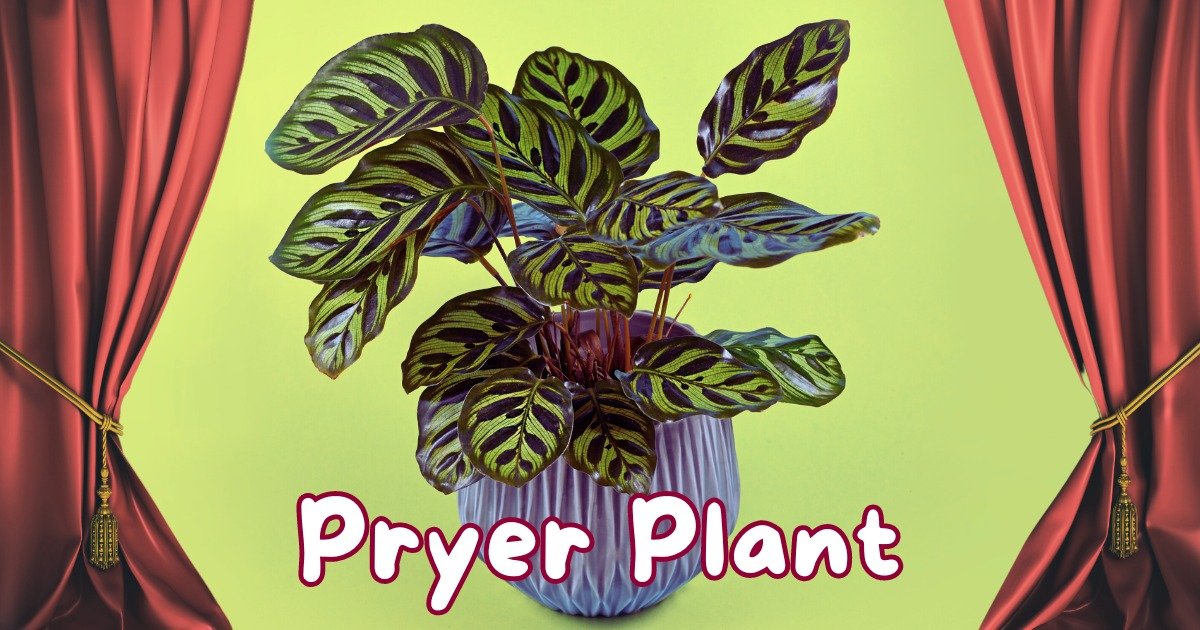Discover why Prayer Plants are the best indoor choice. Learn easy care tips and fun facts about growing happy, healthy Prayer Plants at home.Prayer Plants are very special. Their leaves fold up at night, like praying hands. That’s how they got their name. They are colorful and fun to grow. You can keep them inside your home. They don’t need much light or care. Even kids can grow them. In this blog, you will learn cool facts and simple tips about Prayer Plants. Let’s find out how to make these plants happy and healthy!
Understanding Your Prayer Plant
Understanding your prayer plant is essential for its care and growth. These plants are part of the Marantaceae family, characterized by their vibrant, patterned leaves. The leaves are oval-shaped and can display a variety of colors, such as deep greens, light greens, and even shades of red or purple. This unique coloration is a result of the plant’s adaptation to its native habitat, where it competes for light among larger plants. Understanding the characteristics of your prayer plant will help you create the ideal environment for it to thrive.
The term “prayer plant” comes from the plant’s fascinating behavior of folding its leaves upward at night, resembling hands in prayer. This movement is a natural response to the changing light conditions, allowing the plant to conserve moisture and protect itself from predators. During the day, the leaves open up to capture sunlight, making the plant a beautiful sight in any indoor garden.
Prayer plants are generally considered low-maintenance, making them a popular choice for both beginners and experienced plant enthusiasts. They thrive in bright, indirect light and prefer consistently moist soil. Additionally, prayer plants enjoy high humidity levels, which can be easily achieved through regular misting or the use of a humidifier. Being aware of these characteristics will allow you to provide the best care for your prayer plant, ensuring its vibrant colors and unique growth habits are on full display.
Essential Care Tips for Your Prayer Plant
Taking care of a prayer plant involves understanding its specific needs, which can be broken down into key aspects: light, water, humidity, and temperature. Starting with light, prayer plants thrive in bright, indirect light. While they can tolerate low light conditions, insufficient light may cause their vibrant colors to fade. Direct sunlight can scorch their delicate leaves, so it’s best to position your prayer plant near a window with filtered light. A sheer curtain can help diffuse harsh sunlight, creating a more suitable environment.
Watering is another critical aspect of prayer plant care. These plants enjoy consistently moist soil, so checking the moisture level regularly is essential. A general guideline is to water when the top inch of soil feels dry to the touch. Overwatering can lead to root rot, so it’s important to use well-draining soil and pots with drainage holes. Additionally, using distilled or rainwater is recommended, as prayer plants can be sensitive to chemicals found in tap water, which may harm their health.
Humidity plays a significant role in the overall well-being of your prayer plant. Being a tropical plant, it thrives in high humidity levels. If your home has dry air, particularly during the winter months, consider using a humidifier or placing a tray of water near the plant to increase humidity. Regular misting can also help, but be cautious not to get water on the leaves, as this can lead to mold growth. By addressing these key care aspects, you will create an ideal environment for your prayer plant to flourish.
Propagating Your Prayer Plant: A Step-by-Step Guide
Propagation is an exciting way to expand your prayer plant collection or share this beautiful plant with friends. The most common method of propagating prayer plants is through cuttings. To start, select a healthy stem that has several leaves and cut it just below a node, which is the point where the leaf meets the stem. Using clean, sharp scissors or pruning shears is essential to prevent introducing any pathogens into the plant.
Once you have your cutting, place it in a glass of water, ensuring that the node is submerged while keeping the leaves above the waterline. Set the glass in a warm, bright location but out of direct sunlight. Over the next few weeks, you should observe roots developing from the node. Be patient during this process, as it can take anywhere from two to four weeks for sufficient root growth. Once the roots reach about two to three inches in length, you can transfer the cutting to a pot with moist, well-draining potting soil.
When potting the rooted cutting, be gentle to avoid damaging the delicate roots. Water the newly potted plant thoroughly, ensuring that the soil is evenly moist but not soggy. Place the pot in a spot with indirect light and continue to care for it as you would a mature prayer plant. Monitor the moisture levels closely, and be sure to provide adequate humidity. Propagating prayer plants can be a rewarding experience, and with the right care, your new plant will thrive alongside its parent.
Common Problems and Solutions for Prayer Plants
Despite their resilience, prayer plants can encounter a few common problems that may affect their health and appearance. One of the most frequent issues is yellowing leaves, which can be caused by various factors, including overwatering, underwatering, or exposure to direct sunlight. If the leaves start to yellow, assess your watering routine and light conditions. Adjusting these factors usually resolves the issue. Ensuring that the plant is in a stable environment with consistent watering and appropriate light levels will help restore its vibrancy.
Pests can also be a concern for prayer plant owners. Common pests that may invade your prayer plant include spider mites, aphids, and mealybugs. Regularly inspect the leaves for any signs of infestation, such as tiny webs, sticky residue, or visible bugs. If you notice any pests, act quickly to treat your prayer plant. Using insecticidal soap or neem oil can effectively eliminate many common pests. Be sure to isolate the affected plant to prevent the pests from spreading to other plants in your collection.
Another issue that can arise is leaf drop, which often occurs when the plant is stressed due to environmental changes. This stress can result from temperature fluctuations, low humidity, or improper watering. To mitigate this problem, keep your prayer plant in a stable environment, away from drafts and extreme temperature changes. Ensuring that your plant receives the right care and attention will help prevent these common problems and keep it healthy.
Fertilizing Your Prayer Plant for Optimal Growth
Fertilizing your prayer plant correctly is essential for its growth and overall health. As previously mentioned, a balanced liquid fertilizer is ideal for providing the necessary nutrients. During the growing season, which typically lasts from spring to summer, applying fertilizer every four to six weeks will ensure that your plant receives the essential nutrients it needs to thrive. This periodic feeding will support healthy foliage growth and vibrant colors.
When fertilizing your prayer plant, it’s important to dilute the fertilizer to half the recommended strength. This practice helps to avoid burning the plant’s roots, which can be detrimental to its health. Using a diluted solution will allow the plant to absorb nutrients more effectively without overwhelming it. Additionally, always water your prayer plant thoroughly before applying fertilizer to prevent any potential root burn.
In the fall and winter months, when the plant’s growth naturally slows down, it’s best to reduce the frequency of fertilization to once every couple of months. This adjustment helps prevent the buildup of excess nutrients in the soil, which can lead to imbalances and negatively affect the plant’s health. By paying attention to your prayer plant’s fertilization needs, you can support its growth and ensure it continues to flourish throughout the year.
Decorating with Prayer Plants: Ideas and Inspiration
Prayer plants are not just beautiful additions to your collection; they can also enhance your home decor in numerous ways. Their striking foliage adds a splash of color and texture to any space, making them ideal for various interior design styles. One creative way to showcase your prayer plant is by placing it in a decorative pot that complements your home’s aesthetic. Consider using pots with intricate designs or vibrant colors that highlight the plant’s unique leaves.
Grouping prayer plants with other houseplants can create a lush, indoor jungle effect. Mixing various leaf shapes, sizes, and colors can produce a stunning visual display, drawing attention to the beauty of each plant. You can experiment with different arrangements to find a combination that works best for your space. For instance, pairing a prayer plant with a tall snake plant or a cascading pothos can create an eye-catching focal point in your living room or office.
Hanging baskets are another excellent way to display your prayer plant. Allow the trailing stems to cascade down, adding an elegant touch to your room. This vertical gardening approach can save space while creating a lush environment. Additionally, prayer plants thrive in terrariums, where their humidity needs can be easily met. By incorporating these plants into your decor, you can enjoy their beauty while enhancing the overall ambiance of your home.
Where to Buy Quality Prayer Plants
When looking to purchase a prayer plant, it’s essential to consider your options carefully. Local garden centers often carry a selection of houseplants, including various types of prayer plants. Visiting in person allows you to inspect the plant for health and quality before making a purchase. Look for vibrant leaves without signs of yellowing or pests. A healthy prayer plant will typically have strong stems and well-defined leaf patterns.
Online retailers are another convenient option for purchasing prayer plants. Reputable websites often provide a wider variety of plants, including rare and hard-to-find types. When shopping online, be sure to choose sellers with positive reviews and a clear return policy. This approach will give you peace of mind regarding the quality of your purchase and help you avoid potential issues with unhealthy plants.
Local plant swaps or plant fairs can also be excellent venues for finding quality prayer plants. These events often feature healthy, well-cared-for plants, and you may have the opportunity to connect with other plant enthusiasts who can share tips and advice. Participating in plant swaps allows you to expand your collection while supporting your local gardening community.
You May Also Like: Debby Clarke Belichick: Her Life Beyond the Spotlight
Conclusion
Prayer Plants are not just pretty. They are also full of life and wonder. Their moving leaves make them feel alive. They are easy to grow and care for. Anyone can enjoy them at home. If you want a plant that’s fun, gentle, and unique, try a Prayer Plant. It will make your home greener and happier every day.
Frequently Asked Questions About Prayer Plants
1.What are the light requirements for a prayer plant?
Prayer plants thrive in bright, indirect light and can tolerate low light but may lose vibrancy.
2.How often should I water my prayer plant?
Water when the top inch of soil is dry; keep soil consistently moist but avoid overwatering.
3.Can I propagate my prayer plant in water?
Yes, you can propagate by placing stem cuttings in water until roots form, then transplanting to soil.
4.What should I do if my prayer plant’s leaves are turning yellow?
Yellow leaves may indicate overwatering or too much sunlight. Adjust watering and ensure indirect light.
5.Where can I buy prayer plants?
Purchase prayer plants at local garden centers, reputable online stores, or plant swaps/fairs.

Evelyn White is an experienced content writer with a background in lifestyle, trends, and practical advice. With several years of writing across digital platforms, she specializes in making everyday topics accessible, informative, and engaging. Her goal is to deliver trustworthy, reader-focused content that’s both useful and easy to understand.
Discover more from Try Hard Guides
Subscribe to get the latest posts sent to your email.

